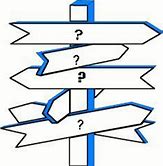Set Out Some Sign Posts
Set Out Some Sign Posts
In the last post we looked at where sermons come from. I quoted from The Sermon Doctor about five things that a speech requires, according to ancient philosophers. The first was the generation of an idea. The second was the organization of the idea. It is to that subject that we turn in this post. Set out some sign posts is the way to organize what you have come up with as you generate your ideas for a sermon.
Where Signs Are Lacking
The church that I served here in Western Michigan had a delightful partnership with a congregation in

Airport in Tegucigalpa
Tegucigalpa, Honduras. We would exchange teams of people who worked in our church, pray for each other, and learn from each other as well. And so, during my years as pastor, I had the privilege of traveling to Honduras and being hosted by gracious brothers and sisters there. Two things amazed me in Tegucigalpa. The first was the landing at the airport. The plane would have to make a huge bank to make it to the landing strip because of a mountain that was on the approach. It was quite a landing.
The second thing that amazed me was the traffic in the city. Cars were crowded into the streets, and travelled without traffic lights and no street signs. I once asked a host who was driving me to a meeting at the church, “How do you know where to go?” He responded, “You just know.”
Your Sign Posts
 Think about your sermon for a moment. You have been studying, most likely, for several days. You’ve thought and thought about your main idea. You know where you are going. Your audience, however, has little idea about what is in your head at that moment. To them, your message could quickly become like me traveling through a crowded town with no street signs.
Think about your sermon for a moment. You have been studying, most likely, for several days. You’ve thought and thought about your main idea. You know where you are going. Your audience, however, has little idea about what is in your head at that moment. To them, your message could quickly become like me traveling through a crowded town with no street signs.
So, what do you do? You set out some sign posts in your message, pointers to where you have been and where you are going.
In order to do this well, you are going to have to think about organizing your sermon backwards. Instead of starting with the idea you have to present, start with those who are going to listen to that sermon. What will give them signs, what will give them bridges to follow along? Make sure you set out some sign posts.
Learning About Sign Posts
I didn’t learn to preach in seminary; I learned it from a rather crusty old preacher that I was assigned to spend a  summer with, working in his church. Part of that work involved preaching regularly and having him evaluate my sermons. The first message I preached didn’t go well. What was wrong? It lacked sign posts. He put it differently, though. He said, “You need to put some pegs in your message where people can grab on as you talk.” That’s just another way of setting out some sign posts in your message.
summer with, working in his church. Part of that work involved preaching regularly and having him evaluate my sermons. The first message I preached didn’t go well. What was wrong? It lacked sign posts. He put it differently, though. He said, “You need to put some pegs in your message where people can grab on as you talk.” That’s just another way of setting out some sign posts in your message.
I practiced that through the summer I spent with him, and have developed the idea over the years. Sometimes I’ve used alliteration, like the Attitudes and Actions that lead to sin. At other times, with another audience, I would use metaphors, like having them imagine an engine that is controlled by a key that starts it, a transmission that translates its power, and wheels that put that power to work.
 When you have an opportunity, look back at your last message. Were there enough signposts? Here is a source for looking at sermons by some of the best known preachers in the American scene. Check out some of them and note how they organize their messages and what sign posts they use.
When you have an opportunity, look back at your last message. Were there enough signposts? Here is a source for looking at sermons by some of the best known preachers in the American scene. Check out some of them and note how they organize their messages and what sign posts they use.



